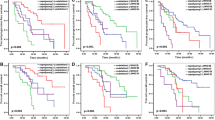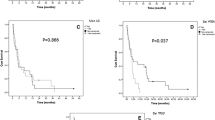Abstract
The clinical significance of chromosomes 1 and 19 deletion was well established in oligodendroglial tumors (ODGs). This study was designed to evaluate the prognostic implication of chromosomes 1 and 19 polysomy in gliomas. 584 patients with histological diagnosis of primary gliomas enrolled in the study. Chromosomes 1 and 19 status was detected with fluorescence in situ hybridization (FISH). Of the 584 cases, the frequency of 1q and 19p polysomy in mixed gliomas was significantly higher than ODGs or astrocytic tumors (1q P = 0.032 and P = 0.044; 19p P = 0.024 and P = 0.027); the frequency of 1q and 19p polysomy in low-grade gliomas (WHO II) was relatively lower compared with WHO III or WHO IV (1q P = 0.097 and P = 0.026; 19p P = 0.04 and P = 0.002). 1q, 19p and co-polysomy were confirmed as risk factors conveyed unfavorable outcomes, which has been further validated in both anaplastic oligodendroglial tumors (AOGs) (P = 0.07, P = 0.028 and P = 0.054 for PFS; P = 0.007, P = 0.001 and P = 0.002 for OS, respectively) and glioblastomas with oligodendroglioma component (GBMOs) (P = 0.005, P < 0.001 and P < 0.001 for PFS; P = 0.136, P = 0.006 and P = 0.051 for OS, respectively). Based on chromosomes 1/19 co-deletion and co-polysomy, AOGs and GBMOs could be divided into three subgroups which harbored distinct prognosis (AOGs P < 0.001 for PFS and P < 0.001 for OS; GBMOs P < 0.001 for PFS and P = 0.012 for OS). Chromosomes 1/19 polysomy are potential prognostic factors which confer unfavorable outcomes. The molecular prognostic grouping model based on chromosomes 1/19 co-polysomy and co-deletion better predicts prognosis and provides a more reliable information for treatment decision-making.


Similar content being viewed by others
References
Schwartzbaum JA, Fisher JL, Aldape KD et al (2006) Epidemiology and molecular pathology of glioma. Nat Clin Pract Neurol 2(494–503):1–516
Omuro A, DeAngelis LM (2013) Glioblastoma and other malignant gliomas: a clinical review. JAMA 310:1842–1850
Jenkins RB, Blair H, Ballman KV et al (2006) A t(1;19)(q10;p10) mediates the combined deletions of 1p and 19q and predicts a better prognosis of patients with oligodendroglioma. Cancer Res 66:9852–9861
Cairncross G, Berkey B, Shaw E et al (2006) Phase III trial of chemotherapy plus radiotherapy compared with radiotherapy alone for pure and mixed anaplastic oligodendroglioma: Intergroup Radiation Therapy Oncology Group Trial 9402. J Clin Oncol 24:2707–2714
Louis DN, Ohgaki H, Wiestler OD et al (2007) The 2007 WHO classification of tumours of the central nervous system. Acta Neuropathol 114:97–109
Ambros PF, Ambros IM (2001) Pathology and biology guidelines for resectable and unresectable neuroblastic tumors and bone marrow examination guidelines. Med Pediatr Oncol 37:492–504
Snuderl M, Eichler AF, Ligon KL et al (2009) Polysomy for chromosomes 1 and 19 predicts earlier recurrence in anaplastic oligodendrogliomas with concurrent 1p/19q loss. Clin Cancer Res 15:6430–6437
Kaloshi G, Benouaich-Amiel A, Diakite F et al (2007) Temozolomide for low-grade gliomas: predictive impact of 1p/19q loss on response and outcome. Neurology 68:1831–1836
Kujas M, Lejeune J, Benouaich-Amiel A et al (2005) Chromosome 1p loss: a favorable prognostic factor in low-grade gliomas. Ann Neurol 58:322–326
Hoang-Xuan K, Capelle L, Kujas M et al (2004) Temozolomide as initial treatment for adults with low-grade oligodendrogliomas or oligoastrocytomas and correlation with chromosome 1p deletions. J Clin Oncol 22:3133–3138
van den Bent MJ, Carpentier AF, Brandes AA et al (2006) Adjuvant procarbazine, lomustine, and vincristine improves progression-free survival but not overall survival in newly diagnosed anaplastic oligodendrogliomas and oligoastrocytomas: a randomized European Organisation for Research and Treatment of Cancer phase III trial. J Clin Oncol 24:2715–2722
Cairncross JG, Ueki K, Zlatescu MC et al (1998) Specific genetic predictors of chemotherapeutic response and survival in patients with anaplastic oligodendrogliomas. J Natl Cancer Inst 90:1473–1479
Jansen M, Yip S, Louis DN (2010) Molecular pathology in adult gliomas: diagnostic, prognostic, and predictive markers. Lancet Neurol 9:717–726
Wiens AL, Cheng L, Bertsch EC et al (2012) Polysomy of chromosomes 1 and/or 19 is common and associated with less favorable clinical outcome in oligodendrogliomas: fluorescent in situ hybridization analysis of 84 consecutive cases. J Neuropathol Exp Neurol 71:618–624
Ren X, Jiang H, Cui X et al (2013) Co-polysomy of chromosome 1q and 19p predicts worse prognosis in 1p/19q codeleted oligodendroglial tumors: FISH analysis of 148 consecutive cases. Neuro Oncol 15:1244–1250
Heegaard S, Sommer HM, Broholm H et al (1995) Proliferating cell nuclear antigen and Ki-67 immunohistochemistry of oligodendrogliomas with special reference to prognosis. Cancer 76:1809–1813
Kros JM, Hop WC, Godschalk JJ et al (1996) Prognostic value of the proliferation-related antigen Ki-67 in oligodendrogliomas. Cancer 78:1107–1113
Hagel C, Krog B, Laas R et al (1999) Prognostic relevance of TP53 mutations, p53 protein, Ki-67 index and conventional histological grading in oligodendrogliomas. J Exp Clin Cancer Res 18:305–309
Theeler BJ, Yung WK, Fuller GN et al (2012) Moving toward molecular classification of diffuse gliomas in adults. Neurology 79:1917–1926
Acknowledgments
We acknowledge financial support by Beijing Natural Science Foundation (7122061).
Conflict of interest
No potential conflict of interest were disclosed.
Author information
Authors and Affiliations
Corresponding author
Electronic supplementary material
Below is the link to the electronic supplementary material.
11060_2014_1526_MOESM1_ESM.tif
Fig. S1 Glioma with 1q (green) polysomy and 1p (red) deletion (a), 19p (green) polysomy and 19q (red) deletion (b). Glioma with 1q (green) diploidy and 1p (red) deletion (c), 19p (green) diploidy and 19q (red) deletion (d)
11060_2014_1526_MOESM2_ESM.tif
Fig. S2 Univariate analyses documented that 1q, 19p and both polysomy were associated with the decreased PFS and OS of patients with AOGs (P = 0.007, P = 0.028 and P = 0.054 for PFS; P = 0.007, P = 0.001 and P = 0.002 for OS, respectively)
11060_2014_1526_MOESM3_ESM.tif
Fig. S3 Univariate analyses documented that 1p, 19q and both deletion were associated with the prolonged PFS and OS of patients with AOGs (P = 0.001, P < 0.001 and P < 0.001 for PFS; P = 0.031, P = 0.017 and P = 0.014 for OS, respectively)
11060_2014_1526_MOESM4_ESM.tif
Fig. S4 Univariate analyses documented that 1q, 19p and both polysomy were associated with the decreased PFS and OS of patients with GBMOs (P = 0.005, P < 0.001 and P < 0.001 for PFS; P = 0.136, P = 0.006 and P = 0.051 for OS, respectively)
11060_2014_1526_MOESM5_ESM.tif
Fig. S5 Univariate analyses documented that 1p, 19q and both deletion were associated with the prolonged PFS and OS of patients with GBMOs (P = 0.005, P = 0.049 and P = 0.009 for PFS; P = 0.011, P = 0.034 and P = 0.015 for OS, respectively)
Rights and permissions
About this article
Cite this article
Jiang, H., Ren, X., Zhang, Z. et al. Polysomy of chromosomes 1 and 19: an underestimated prognostic factor in oligodendroglial tumors. J Neurooncol 120, 131–138 (2014). https://doi.org/10.1007/s11060-014-1526-y
Received:
Accepted:
Published:
Issue Date:
DOI: https://doi.org/10.1007/s11060-014-1526-y




